Family : Psittacidae

Text © Dr Davide Guadagnini

English translation by Mario Beltramini
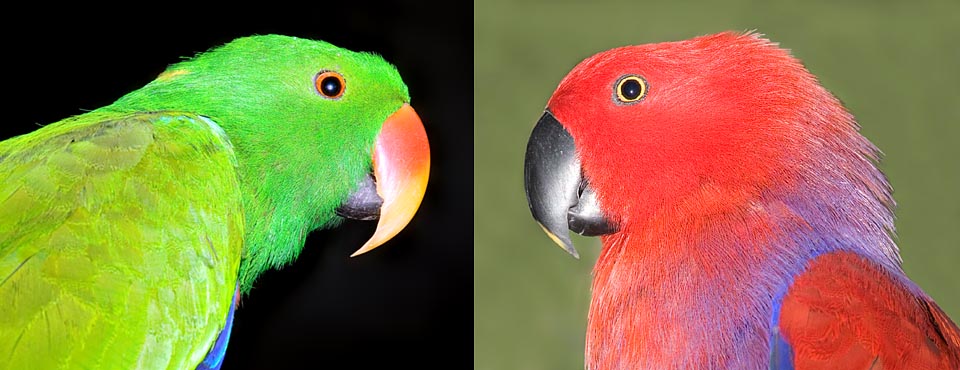
Eclectus roratus confronted male and female. Dimorphism is such that for years scholars thought they were two different species © Giuseppe Mazza
The Eclectus parrot (Eclectus roratus Muller 1776) is a bird belonging to the order of the Psittaciforms (Psittaciformes), family of the Psittacids (Psittacidae), subfamily Psittacinae, tribe of the Psittaculins (Psittaculini), genus Eclectus to which belongs as unique species with, presumably, 9 subspecies. In fact, there is no agreement among those dealing the classification. Furthermore, the study of some subspecies is very difficult due the geographic inaccessibility and/or due to problems of cultural/political order which render difficult to achieve the direct observations of the species in its own different habitats.
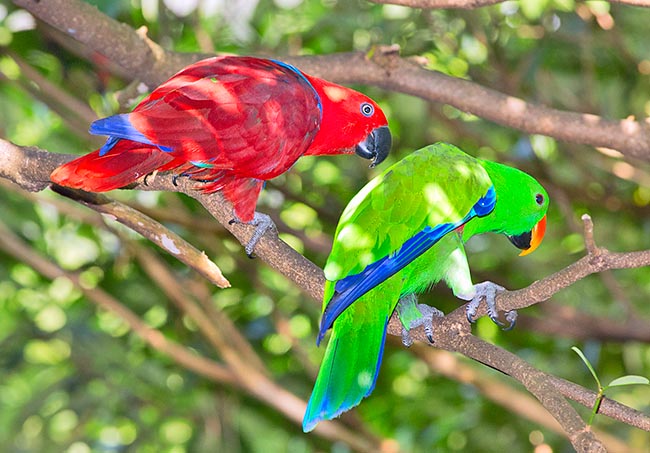
Evolutionary talking males are usually more coloured, but here it’s the contrary © Giuseppe Mazza
The remains of another species belonging to the genus Eclectus have been found in some archaeological sites in the islands of Tonga and Vanuatu; it is the Eclectus infectus that became extinct about 3000 years ago due to the arrival of the man on these islands destroying the habitat of this species and introducing allochthonous animals who entered in strong competition with this resident parrot.
The term indicating the genus “eclectus” is a Latinism borrowed from the Greek “eklego (εκλεγω)”. “Εκλεγω” means chosen, distinct, selected from which comes the epithet eclectic and indicates the different colourations related with the sex.
For what concerns the term indicating the species, “roratus” comes from the Latin, from the verb roro and means “to be wet, sprayed, wet drop by drop as by the dew” and refers to the brightness of the colours of this species in both sexes and which may give the sensation of a “wet effect”.
Zoogeography
The natural range of the Eclectus parrot goes from the Moluccas to Sumba Island; from New Guinea and adjacent islands to the Bismarck Archipelago and the Solomon Islands and reaches north-eastern Australia (Cape York Peninsula); depending on the area the species is distributed with different subspecies and populations.
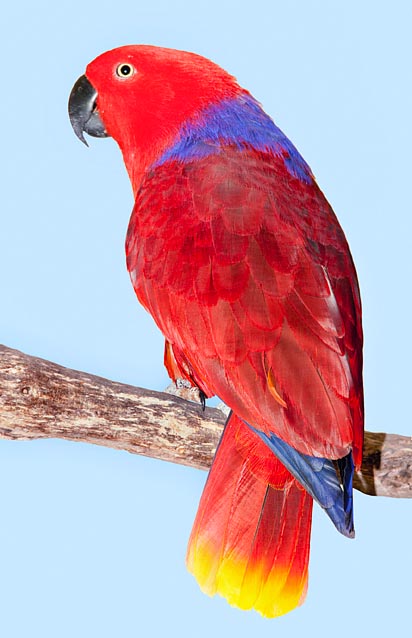
The showy female livery is mimetic in the foliage shade © G. Mazza
Ecology-Habitat
These parrots live in the thick of jungles where they can hardly be seen, in fact, the habitat is formed by the primary and secondary forests, by wooded savannahs and by the tropical forests up to about the 1000 m of altitude.
Morpho-physiology
It is a medium-sized parrot; it has a length of about 30-40 cm.
The Eclectus is the species of parrot having the most extreme sexual dimorphism and, furthermore, the female is livelier and more contrastingly coloured than the male. The colours of the livery are so much different between male and female that the nineteenth century and to the early 20th century natural scientists initially did classify them as two distinct species. The males of this species were, among other things, described long before discovering the females which, in spite of the colour, are less detectable as the violet red camouflages well in the darkness of the foliage and also because the females remain hidden in the nests having behaviours that put them much less on sight than the males.
Actually, the Eclectus parrot is considered, even nowadays, a mysterious species that still poses many questions to the evolution scholars. For instance, in all the species of parakeet parrots the males appear more intensely coloured than the females.
In this species the ruby and blue-violet (in some subspecies the blue-violet is absent) females contrast enormously from their males who are almost completely of bright emerald green colour. The female has the head, up to beyond the nape and, in front, up to the beginning of the chest, of a bright red colour. After the red, ventrally, starting from the rest of the chest up to the whole abdomen it presents a very characteristic violet-blue colour. The blue-violet colouration forms also a sort of a collar that runs around the base of the neck and then rejoins the portion of chest having the same colour. Also the coverts of the dorsal margin of the wing have the same colour with more light bluish tonalities. The primary and secondary rectrices, dorsally, are always bluish-violaceous with portions of tonalities darker/brown and dark red ones; they may have some suffusions of green. Ventrally, the same feathers are brown-blackish. The back and the wings are red; a darker red in respect to that of the head. Also the tail, dorsally, is red even if the flight feathers, towards the base are darker (brownish) and can have green-bluish portions. Ventrally, the flight feathers are brown-black. In some subspecies the final margin of the flight feathers and the rump are yellow; in some subspecies the chest-ventral blue-violet belt may have shades and intensity rather different or may be totally absent (in these last instances the specimens are almost entirely red).
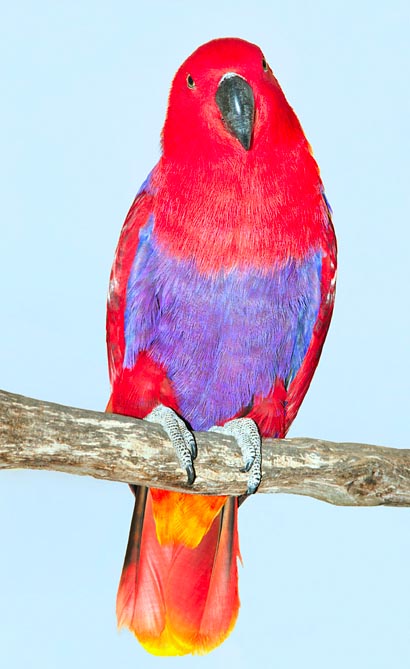
Moreover females spend 9 months hidden near the nest © G. Mazza
The differences connected to the subspecies are more observable in the female, having the males of the various subspecies, more similar liveries. Both sexes can have, on the contrary, variations of size and weight depending on the subspecies (the weight can, usually, vary from 370 to 610 g).
The male has a very bright green “lizard” colour; the dorsal margin of the wings is pale sky light blue. The underwing is pale red; this colour (which is totally appreciated when the bird is flying) extends for a portion of the sides drawing a semicircle (always not appreciable when the wings are closed). When the parrot is in such position, of red colour, two parallel stripes-spots and internal in respect to the margins of the closed wings are seen.
The flight feathers and the primary and secondary ones of the wings, dorsally, have a colouration with parts of brown, parts of green and parts of light blue-blue (this last colour is more extended on the feathers of the wing). Ventrally, these same feathers are brown-black; the margin of the flight feathers can be shaded in yellow-cream. The legs are grey with darker nails. Besides the macroscopic differences of the livery there are other parts of the body much different between male and female: the bill of the female is completely black whilst that of the male has the upper rhamphotheca of orange colour, with the tip shading in yellow, very inconspicuous; the eye of the male has brown-orange-dark reddish iris, the irides of the females are, on the contrary, bright yellow contrasting in an almost luminous way with the black pupil.
It is a unique case of natural selection with a phenomenon of bichromatism, and even inverted, pushed to the extreme. In the young, which already present the adult colouration, the bill is totally black and the eyes are brown in both sexes.
Subspecies
The univocally recognized subspecies of Eclectus roratus are:
Eclectus roratus roratus Muller, 1776. It is the nominal subspecies (that is, the first discovered and described by the man). It is about 35 cm long, weighs 380-475 g and has stumpy structure; it lives in the southern Moluccas Islands including the islands of Burum and Ceram and its range partly overlaps to that of the subspecies later on described in the island of Ceram. The male as well as the female have duller colours than the subspecies vosmaeri; the male has the tail bordered in pale yellow (more evident below), the tail of the female is orange shades.
Eclectus roratus vosmaeri Rothchild, 1922. It is bigger (the second subspecies in order of size) than the nominal subspecies with a length of 38 cm and a weight of 430-540 g: it characterizes due to a much bright livery and very elegant elongated look. The male has pale (more yellowish) green grass head and nape and blue tail with pale yellow border, also the red of the underwing is very evident and is present also on the thigh. The female, which has a much brighter red than all other subspecies, has yellow rump and intense yellow tail border. The blue-lavender feathers of the chest have a filiform-hairy look. This subspecies lives in the Maluku Islands (northern islands of the Moluccas Archipelago).
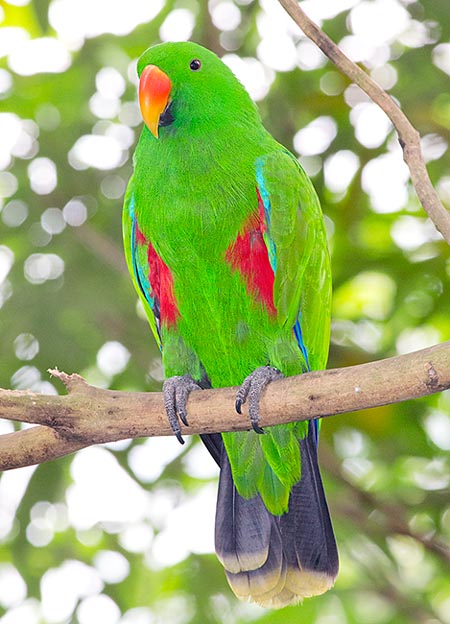
For this, males were discovered and named many years before © G. Mazza
Eclectus roratus cornelia Bonaparte, 1850. About 37 cm long, it weighs 450-540 g, its range is limited to the island of Sumba; the male is of a paler green colour and has bluer tail than the Eclectus roratus roratus, the iris is golden-amber, the female is very particular being totally red (also the tail is red), but the blue primary feathers. Also this subspecies is bigger and brighter than the nominal one.
Eclectus roratus riedeli A.B. Meyer, 1882. It is smaller than the nominal subspecies being about 33 cm long and weighing 380-410 g; it is the other subspecies with female wholly red (the red is darker than that of the subspecies cornelia) always excepting the blue primary feathers and a wide yellow border of the tail and the coverts of the rump which are always yellow. The male has a shade of blush colour on the neck and the cheeks and has the tail bordered of yellow. It lives in the Tanimbar Islands (in eastern Indonesia).
Eclectus roratus polychloros Scopoli, 1786. It is bigger than the nominal subspecies; is 37 cm long and weighs 470-525 g. The male has the livery of intense green colour slightly shaded of blue and yellow, has a wide pale yellow band on the tail (bigger than the subspecies vosmaeri). The female of this subspecies has a periocular ring of blue feathers, the blue portion of the livery passes on the chest and close to the wings forming a drawing with angles typical of the subspecies; the tail is dark at the base, red in the central part and ends with pink-orange shades. It is distributed from the Kai Islands up to western Papua to New Guinea to the Kiriwina Islands, on the D’Entrecasteaux Islands up to the Lousiade Archpelago; it has been introduced also in other islands.
Eclectus roratus macgillivrayi Mathews, 1913. Long about 40 cm and with a weight of about 450-610 g. It s the subspecies living in the Cape York Peninsula in the Australian continent and is the biggest subspecies, similar to the subspecies vosmaeri; the male has the tail bordered of yellow. The specimens of this subspecies have an elongated and imposing look.
Eclectus roratus solomonensis Rothchild e Hartert, 1901. The specimens of this subspecies have an average length of 33-34 cm and weigh 390-425 g; it has a very ample distribution, from the Bismarck Archipelago up to the Solomon Islands and various adjacent islets; it resembles the subspecies polychloros against which is smaller; the male has the livery of a nice green-bright yellowish colour, quite bluish tail and ample red spot of the underwing which reaches the thighs. It has the upper rhamphoteca of the bill of a paler orange colour. The female has a short and roundish look, has an ample light blue periocular ring and the feathers of the wing are partly light blue. The iris is straw yellow.
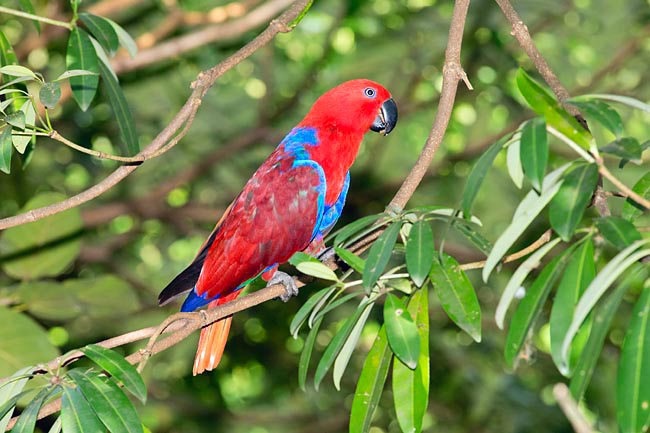
In the reproducing time female often has several males together and is fed with the young © Giuseppe Mazza
Eclectus roratus biaki Hartert, 1932. It is about 35 cm long and weighs about 375-425 g. Its range is formed by the islands of the Geelvink Bay in New Guinea; this subspecies is not univocally recognized. The male is dark, intense and brilliant green, and the feathers have a light striped design like a “fishbone”, the tail has a pale yellow border. The iris is orange-reddish. The female is characterized for having a well marked blue-violet periocular ring and which highlights the white-yellow-silvery iris. The specimens of this subspecies have filiform look and adherent to the body plumage.
Eclectus roratus aruensis G.R.Gray, 1858. The specimens of this subspecies are about 37-38 cm long and weigh about 430-540 g. Endemic to the Aru Islands, it is big with long and narrow structure and tail longer than the other subspecies. The male is characterized by an ample pale yellow border on the tail and by bright red iris. Also the female has elongated shape with little dark tale and more red bright.
It seems that the Eclectus parrot has had its origin in New Guinea and has expanded to the surrounding islands differentiating with endemism characteristics in the new sites and islands colonized. In any case also inside the same subspecies there may be certain variability in size and colouration until getting to differences connected to different populations succeeding inside the same subspecies but resulting partially or totally separated by geographic barriers. Maintaining this great genetic variability by avoiding at least the crossings between the different subspecies (if not even between the different populations) should be very important for not destroying irreparably the extraordinary biodiversity of this parrot.
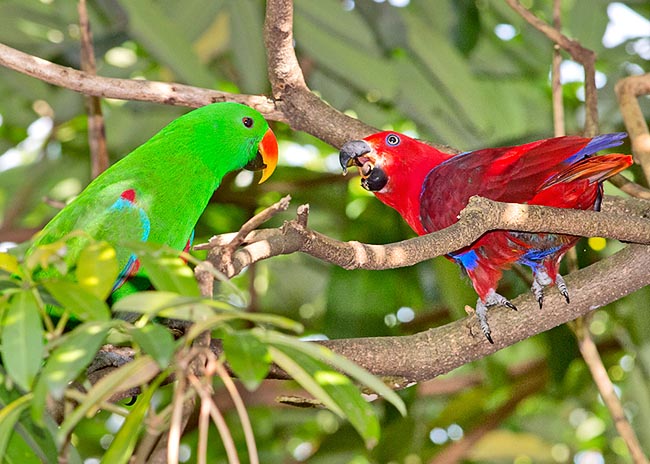
The Eclectus society is therefore polyandric where wives are heard © Giuseppe Mazza
Ethology-Reproductive Biology
The Eclectus parrot moves in small groups looking for the food formed by fruits and vegetal parts of various type (seeds, flowers, nectar, buds, leaves); in the evening various flocks can rally even in a great number of trees, in common use, where to spend the night.
This species reproduces in hollows of branches and trees which are sought on the higher and most inaccessible trees; so much that it is very difficult to be able to document the reproduction in the wild.
In the wild state, the species appears to have polyandric behaviours with the presence even of several males which take care at the same time of one unique female and, as a consequence, of one unique brood.
The female cares the eggs and the small newborns getting out from the nest quite rarely and when gets out, often, keeps in the immediate vicinity and only for the time necessary for being nourished by the male (males) and for performing its own physiological necessities.
The mature females spend a great deal of their time in the nests which they defend furiously. This behaviour, which occurs also in artificial habitat, seems to have the main purpose of not being stolen of the nesting site by other females. The behaviour of defending the nest is so rooted that an adult female can spend even 9 and more consecutive months in the nest; if we think that the breeding of a hatching requires an engagement of about 3 months, the defence and occupation of the nesting site reveals being an extremely demanding activity.
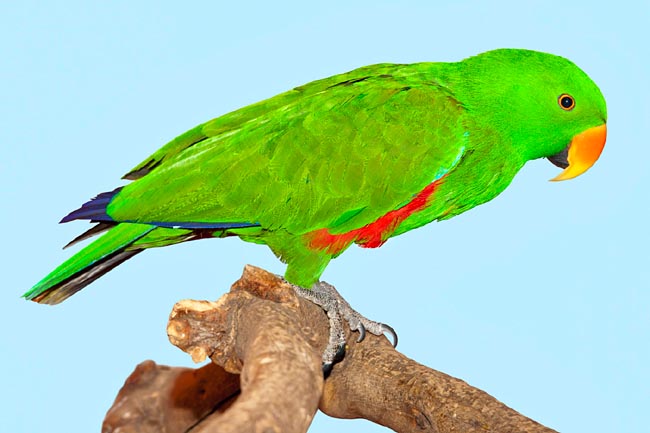
Males, also in captivity, are much milder and meek than their partners © Giuseppe Mazza
When a female, in the nest, feels menaced, emits some very strong vocalizations, ruffles the feathers and, keeping the wings open, it attacks the possible intruder with the bill wide open. Some naturalists hypothesize that the bright colour of the females has evolved for signalling, in a showy way, the occupied nesting site by protruding from the edge itself of the nest thus “inviting” the other females to keep away.
The males, as it has been observed in the specimens born in captivity, tend to be milder and more docile than the females.
The typical brood of the Eclectus consists in two white eggs about 4-5 cm long (it may spawn 1 or 3 eggs quite rarely) and the incubation lasts 28 days. The young are born featherless, are pale pink (the colour of the skin) and with closed eyes. While growing, they will open the eyes when about 10 days old and will gradually cover of a dark grey down which will become very thick by the first month of life and will grant a roundish look to the young Eclectus parrots. Always around the 25-30 days of age, the feathers will begin to come out and, having already the typical colouration of the adult, will allow distinguishing the males from the females already at this early age.
When the young will leave the nest, at about 60-80 days of age, they will be fed also directly by the males (males). The adult age will occur when 2-3 years old and they will be able to live 30 and more years.
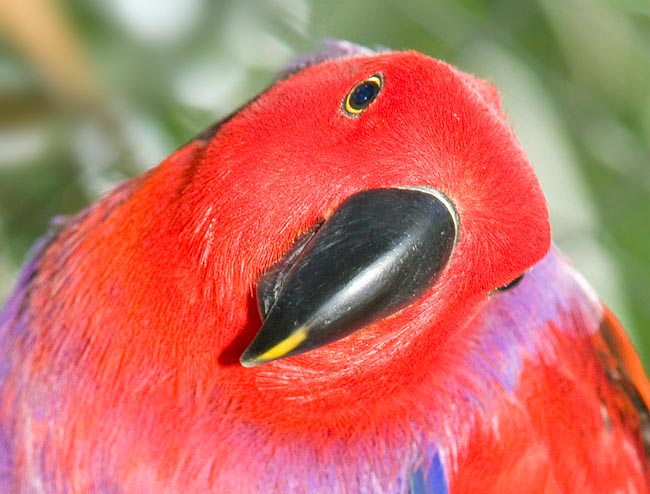
The nest usually contains 2 eggs. Young have a life expectancy of 30 years © Giuseppe Mazza
Due to its beauty, this species of parrot is fairly diffused in captivity and is bred usually in pair with quite satisfying reproductive results. Due to the high cognitive and manipulative capacities (carried out by using the bill and the legs), this species (as well as the other species of bred parrots) is to be accommodated in aviaries of suitable dimensions and rich of perches and of furnishings which may give the possibility to the birds to fly and to be able to express their own natural behaviours in order to avoid various problematics such as, for instance, the self-mutilation of the plumage and the stress syndromes.
In captivity, the alimentation must be rich in fruit, vegetables with green leaves and fresh buds for furnishing beta-carotene. Also vegetables of other type are important, also cooked, such as the legumes; the dried seeds and the nuts are to be administered in a rationed way in order to avoid the frequent negative phenomenon of the obesity.
In this respect, as alternative, as dried food we can utilize specific extruded feed. Edible flowers, nectar and low-fat yoghurt may be given from time to time as food enrichments; avocado, chocolate, human cooking leftovers and other are to be avoided because unhealthy or even toxic.
Unluckily, the Eclectus parrots are still now hunted in the wild, particularly by some populations and local tribes, because they are considered as harmful animals being fruits consumers and because their colourful feathers are used as decorative elements in the traditional costumes. For this reason, some localized subspecies and populations have become very rare.
→ For general information about Psittaciformes please click here.
→ To appreciate the biodiversity within PSITTACIFORMES please click here.
